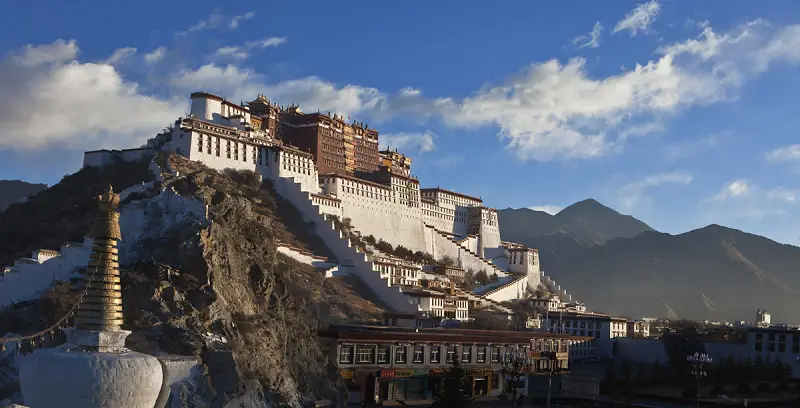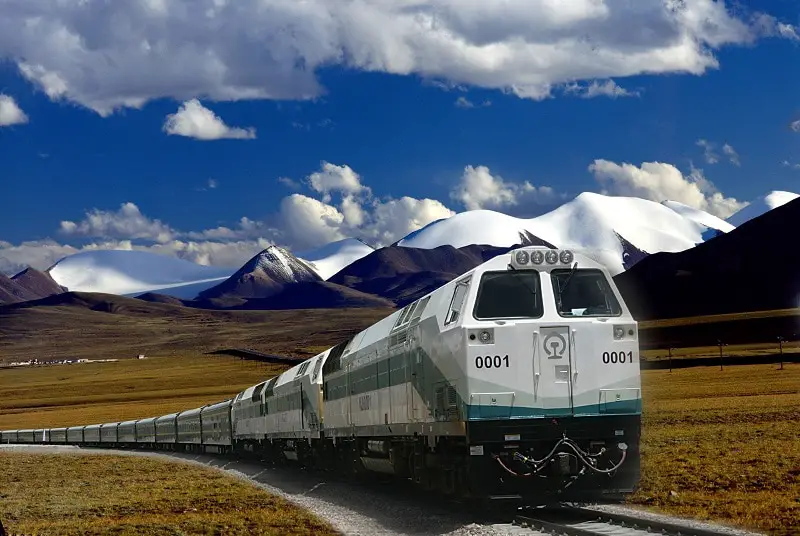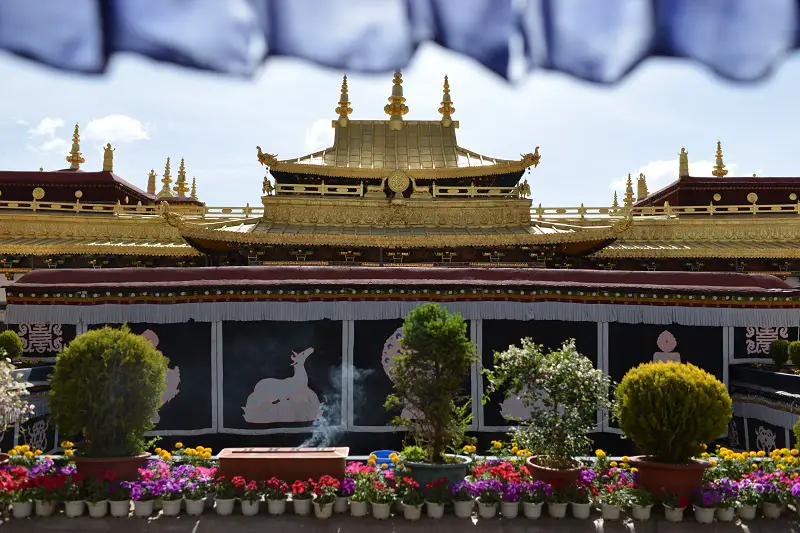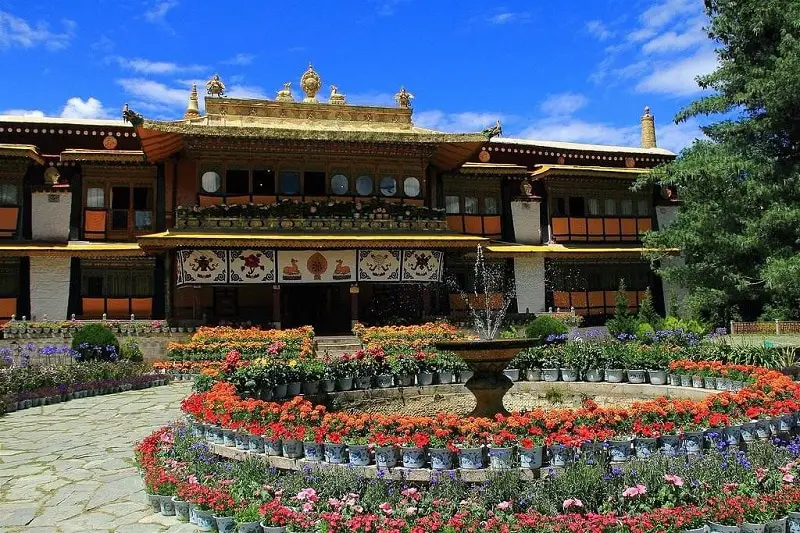Lhasa, in Tibet, is a place of utmost tourist interest. Tibet itself ranks high among the favorite tourist destination and Lhasa remains in their list of ‘must-visit’ places for Tibet travel. Lhasa is the administrative capital of the Tibet Autonomous Region. Lying on the north bank of Lhasa River, in a valley of Himalaya, it stands at an elevation of 3,656m with an area of 30,000 square kilometers.
On account of its high elevation, accessibility too many of its places is still limited. But Lhasa remains the chief tourist attraction all over the world owing to the authentic Tibetan culture, the accurate Tibetan enigma and the spectacular scenic beauty. Moreover some of the Gelugpa monasteries like Sera monastery, Ganden monastery and Drepung monasteries are present in or around Lhasa, which holds immense importance within the Tibetans.
Further the various festivals held in the Gelugpa monasteries like the Shoton or yoghurt festival, the Chotrul Duchen or the butter-lamps festival, the Ganden Thangka, the Sera Bengqin festival along with Tibetan opera and songs and dances, the revelation of Buddha statue, reflect the religious and cultural charm of the Tibetans. However Lhasa not only holds pious interests, but it is also the center of Tibetan economy and politics.
How to get to Lhasa
Lhasa can be reached with the help of flights, trains and by road also. The Lhasa Gonggar airport is the name of the airport serving the city of Lhasa. There are many direct and many connecting flights to Lhasa. The city can be reached both from China and Nepal. The facilities of Lhasa flights with proper and authentic Tibetan food and comfortable seats and alignments appeal to the tourists. Moreover the safety facilities with parachutes and oxygen masks, proper restroom facilities make the journey secure and comfortable. By flight, the time taken to reach Lhasa is also less. The only negative aspect about the journey by flight is that the altitude problem tends to develop faster as the body gets less time to acclimatize.
The Lhasa Railway station is a fairly big station with ample trains connecting Lhasa with Nepal and rest of China. The trains are well scheduled, numerous and even punctual. The Lhasa Railway offers remarkable services to the tourists with adequate security. It has built-in oxygen supply kits. One remains in the chambers for the passengers and the other aims at controlling the oxygen supply through the control of air and temperature control systems. Proper maintenance is done regularly. The dining car contains many other snacks and beverages and other types of food. The train offers catering services and the tourists are also allowed to choose their own packaged foods. The rest room is also well maintained with enough spaces and amenities like proper supply of water and fresheners. The train however takes a lot of time sometimes even 42 hours to 50 hours. But the journey lacks monotony because of the beautiful scenic beauty it involves. Also the body gets more time to acclimatize and remains healthy.
By road, Lhasa can be reached from Kathmandu, through the Sino-Nepal border or the Zhangmu border. The journey is no doubt mind-boggling but quite challenging. The recent earthquake has affected the accessibility of many roads connecting Lhasa, so a detailed survey is required to be done before choosing this mode of journey.
The best time to visit Lhasa will be from March to October. Due to its high altitude, winter time is really difficult to spend in Lhasa.
Places to visit in Lhasa
-
Potala Palace
Potala Palace in Lhasa remains the number one tourist attraction. It is a huge palace containing several houses, chapels and towers and is located on the Red Hill, by the side of the Lhasa River, in the northern part of Lhasa. It is the UNESCO World Heritage Site along with the Jokhang temple and Norbulingka. The palace is spectacular because of its architectural magnificence and rich treasury of true Tibetan culture and precious art. By the Guinness Book of World Records Potala Palace is the highest palace in the world, standing at an altitude of 3700m. The whole palace was built by woods and stones with a granite piling of the walls. There are several beautiful carvings about Buddha. The palace can be divided into White palace and Red Palace. Besides the splendid architecture, standing tall in 117 meters, the artwork is spectacular. It contains about 698 murals, describing the history of Buddhism and Tibet, wall carvings, Thangkas, paintings on clothes, papers and silks, religious figures and Buddhist doctrines. The two meters high statue of Tsong Khapa, a silver statue of Padmasambhava, and statues of Sakyamunis are true treats to the eyes of the tourists. Some tips regarding the visit of Potala Palace must be remembered.
- The tickets cost around 4$ during May to October and 15$ during November to April. Less than 2,300 tourists are allowed to visit the Palace at a time and the time specification is 9:00 to 16:00.
- Always carry your passport and Tibet Travel Permit.
- Dharma Cave, the Stupa of fifth Dalai Lama and Kwun Yum Hall should not be missed in the limited time span.
- Photography is not allowed inside.
- Only one restroom is situated at the West gate and it is worth a try.
- The location of the Potala Palace is 70km from Lhasa Gonggar Airport and 20km Lhasa Railway Station.
-
Jokhang Temple
The word Jokhang means the ‘abode of Buddha’. Indeed Jokhang temple is the principle centre of Gelugpa sect of Tibetan Buddhism. Located in the centre of the city of Lhasa, it has an area of 25,000 square meters. It is the chief attraction of the pilgrims and also the tourists, marked as the UNESCO World Heritage Site. It is a timber complex consisting of four storeys. The temple exhibits the mesmerizing architectural style of the Tang Dynasty of Tibet, with a beautiful golden top. The place has a religious ambience all over it. There are numerous stone slabs containing the historical inscriptions of the alliance between Tibetan king and Tang Dynasty, the people’s teaching and many others. The eastern part of the temple contains votive lights, which flickers and guides the tourists to the main hall, the 1,300 years old complex. The entrance is flanked by a Dharma Wheel Chakra with two deer on each side, located on the top.
The main attraction of the place is however the life sized statue of sitting Sakyamuni. The statue is gilded many times with jewels and other precious metals. This is the holiest figure for the Buddhist pilgrims. The best time to visit Jokhang temple is during the Tibetan New Year celebration which occurs during late January and early March. During this time, the pilgrims celebrate and offer full reverence with colourful religious flags and offerings. Some tips about Jokhang temple are-
- The entry fee to the temple is around 12.5$. The location of the temple makes it accessible from all regions. It is located 5km east of Potala Palace, in the middle of the Barkhor Street ciruit.
- Two hours is enough to admire the charm of the place.
- Opening hours are from 7:00 to 12:00 and 15:00 to 18:30.
-
Barkhor Street
It is a popular tourist as well as pilgrim destination in Lhasa. Located in central Lhasa, Barkhor Street embodies true Tibetan charm and aestheticism. It is also considered to be a famous destination for wedding photography, along with the Potala Palace. The street is very ancient and surrounds the Jokhang temple. Many pilgrims hold the prayer wheels and walk clockwise along this street, around the Jokhang temple, performing the kora ceremony. It is constructed with hand polished stone boards and though it is not very broad, it can accommodate thousands of visitors. The street also consists of innumerable shops selling the prayer wheels, ‘chuba’ the traditional Tibetan dress, Thangka, the Tibetan scroll painting. Many other exotic Tibetan items are also sold here. Some tips to remember for the visit of the Barkhor street-
- Always walk clockwise in the street. The pilgrims usually walk clockwise, circumnavigating the Jokhang temple.
- Before deciding to buy anything, ask at least two to three shops, the price of the material. Bargaining is a must in the shops of Barkhor Street.
- Respect the pilgrims. Ask their permission before clicking pictures of them or with them.
- Try to avoid the lane after dark as the many sub lanes increase the chance of getting lost.
- Always keep the passport and hotel details along with you.
-
Sweet Tea House
The Guangming Kamqung Sweet Tea House is located in the Barkhor Street in Lhasa. It is the oldest and is considered to be the most popular amongst the several other tea houses that are located there. The tea house is simple consisting of several wooden tables and comfortable chairs. The tea prepared there provides the taste of authentic Tibetan tea, especially the butter tea. The tea house demands an entrance, after the tiring tour of the Jokhang temple and the Barkhor Street. The Tibetan people flock there either chatting or playing dices and the house is the vision of genuine Tibetan atmosphere. The tea should be enjoyed with some Tibetan snacks or noodles. A cup of tea costs around 0.7 CNY.
-
Norbulingka
The Norbulingka or the ‘summer house of Dalai Lama’ is situated on the western edge of Lhasa. It is considered to be the biggest man made garden in the Tibet Autonomous Region. It used to be the summer palace of Dalai Lamas, who resided here and conducted the government and religious issues. The palace occupies an area of about 360,000 square meters with 374 rooms where the 7th to 14th Dalai Lama resided. This is a palace providing some brilliant examples of ‘Potrang’ or Tibetan palaces. Spectacular Thangkas, some old Buddhist statues, and beautiful wall paintings are kept here. The other sites which must be visited are namely the Tyokil Potrang, Kelsang Potrang and Takten Migyur Potrang.
Decorated with gold covered roof and copper tiles, the Tyokil Potrang is considered to be the top scenic spot here. It contains several murals and Buddhist statues. The Kelsang Potrang is the first palace in Norbulingka, containing the main Assembly Hall. The murals on the second floor of this palace are worth visiting. The Takten Migyur Potrang is the new palace, built by the 14th Dalai Lama. It is an elegant and largest palace and is an amalgamation of temple and villa. The main importance of Norbulingka is that it features many festivals like the popular Shoton festival, occurring after the Buddhist exhibition in the Drepung monastery. Further the tourists are also allowed to hold picnic in the garden and they can see the authentic Tibetan opera and other shows held here. Some tips about the visit is-
- Many buses are available for the trip to Norbulingka. From there you can visit to Jokhang temple, Barkhor Street or Potala Palace.
- The best seasons to visit is the summer and autumn.
- The ticket price is 8.8$ each. For visiting the zoo, the tourists have to provide an extra 1.4$.
- The whole tour of Norbulingka might take 2 to 3 hours.
- The tourists can also enjoy the Tibetan tea, Tibetan shows besides the festivals.




